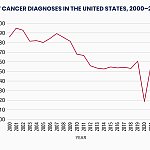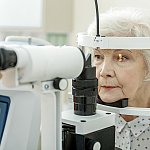
The importance of regular breast cancer screenings cannot be overstated.
Tina Knowles, the mother of pop and R&B stars Beyoncé and Solange, recently revealed she was diagnosed in 2024 with stage 1A breast cancer after missing her regular mammogram appointment.
Knowles, 71, said she delayed her breast cancer screening during the COVID-19 pandemic and then didn’t get the exam rescheduled for another four years.
The mammogram revealed that Knowles, who is an entrepreneur, fashion designer, and philanthropist, had a benign tumor in her right breast and a cancerous tumor in her left breast.
Knowles underwent surgery to remove the tumors. She is now cancer-free. Knowles’ former husband, Matthew Knowles, is also a breast cancer survivor.
“I think as women, sometimes we get so busy and we get so wrapped up and running around, but you must go get your test,” Knowles told People magazine. “Because if I had not gotten my test early, I mean, I shudder to think what could have happened to me.”
In her new book, “Matriarch: A Memoir,” Knowles also discusses how a hospital surgeon and an oncologist “talked down” to her about her diagnosis. She then met with a private surgeon who arranged for her to consult with other medical professionals at the hospital.
“A lot of people, especially Black people, feel they have to go with the doctor they are given even if we are not treated well. You deserve second opinions and it’s your opinion that sets the decision,” Knowles told The Today show.
The American Cancer Society (ACS)
The organization also states that women ages 45 to 54 should get mammograms every year, and women ages 55 and older can undergo them every other year.
The ACS states that screenings for all women should continue as long as the woman is in good health and is expected to live at least 10 more years.
A mammogram is an X-ray used to scan breast tissue for cancer and other irregularities. A 3D mammogram is a more advanced breast cancer screening tool that utilizes multiple X-rays taken from different angles.
“Mammograms are the most effective and widely recommended screening tool for breast cancer. Women with higher risk may need MRI in addition to mammograms,” said Tatiana Kelil, MD, the interim chief of the Breast Imaging Division and co-director for the Center for Advanced 3D+ Technologies in the Department of Radiology at the University of California San Francisco.
Experts affirm that regular screenings are important. Among other factors, mammograms can miss
“Annual mammograms are recommended because of the rate at which breast cancers typically grow in early stages,” explained
“More frequent tests may be necessary if a person is at high risk (hereditary breast cancers, strong family history) or if suspicious findings were present on previous studies,” she told Healthline. “Interval breast cancers (those that arise between imaging tests) tend to be more aggressive and can spread more quickly than usual. This is why it is important not to skip a mammogram.”
“Screening is important to help identify breast cancer (if it were to develop) at the earliest possible stage,” added Mediget Teshome, MD, the chief of breast surgery and director of breast health at the UCLA Health Jonsson Comprehensive Cancer Center.
“The stage then informs treatment recommendations and is associated with prognosis with early-stage disease associated with improved survival outcomes,” she told Healthline.
Outside of skin cancers,
It’s estimated that more than 300,000 new cases of invasive breast cancer will be diagnosed in females in the United States in 2025. About 42,000 of these females will die from the disease this year.
Breast cancer is the second leading cause of cancer death in females in the United States. Only lung cancer kills more females.
Overall, the average risk of a woman in the United States developing breast cancer during her lifetime is about 13%. The incidence rate has increased by about 1% per year in recent years.
Common symptoms of breast cancer may include:
Breast cancer treatment may vary depending on what stage it’s discovered and how aggressive the disease has developed in a person, and may include:
“Annual screening mammography, regardless of the woman’s age, has been proven beyond any doubt to reduce the risk of dying from breast cancer,” said Richard Reitherman, MD, a radiologist and medical director of breast imaging at MemorialCare Breast Center at Orange Coast Medical Center in California.
“A woman having annual screening mammograms markedly reduces her personal chance of dying from breast cancer [and] markedly reduces the intensity of treatment effects and therefore fewer long-term side effects,” he told Healthline.
However, breast cancer can be more aggressive and more difficult to treat in females under 40.
The ACS
“It’s important for younger women to get regular breast cancer screenings because breast cancer can occur at any age and early detection saves lives,” Kelil told Healthline. “Starting screening at the right time helps catch cancer when it’s most treatable.”
“It is important for women to understand that when you are younger, the breast tissue may be harder to interpret on mammogram since most women’s breast are denser when they are younger,” said Janie Grumley, MD, a breast surgical oncologist and director of the Margie Petersen Breast Center at Providence Saint John’s Center as well as an associate professor of surgery at Saint John’s Cancer Institute in California.
“They may be at higher risk of being called back for additional imaging. However, younger patients are less likely to have actual cancer. They can have a number of other benign findings, but additional work-up may be needed to determine if the finding is benign,” she told Healthline.
Black women in the United States face
One reason is that Black women have a higher risk of developing triple-negative breast cancer, a particularly aggressive form of the disease.
Black women also have higher rates of some risk factors for breast cancer, such as obesity, heart disease, and diabetes.
Researchers have noted that Black women are also more likely to experience stress due to racism and other factors. Chronic stress can contribute to more aggressive tumors.
In addition, some beauty products commonly used by Black women, such as hair relaxers, have been
Experts say it’s important for the public and medical professionals to be aware of these facts.
“It is important for all women to have access to breast cancer screening and treatment,” said Teshome.
“There are well-established observed disparities in breast cancer outcomes and mortality by race/ethnicity and other social factors that we should consider unacceptable. Cancer does not discriminate and in order to improve the health of all men and women with breast cancer, timely access to preventative, diagnostic and therapeutic interventions is paramount.”
“Breast cancer affects women across all backgrounds. However, disparities in access can lead to later-stage diagnoses, worse outcomes, and higher mortality, especially in underserved communities,” added Kelil.





